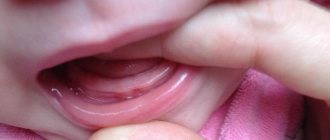Baby urine color
The color of urine depends primarily on the age and nutritional pattern of the baby.
The older the child, the darker the color of his urine. Its coloring is promoted by eating certain foods and taking certain medications. If the baby is breastfed, then the mother's inclusion of beets, carrots and citrus fruits in the diet can change the color of the urine. As a rule, the urine of a child under one year old is very light. Over time, it becomes straw yellow. If urine contains a lot of bilirubin, it becomes dark brown. This is one of the manifestations of neonatal jaundice and requires supervision by a pediatrician. You should definitely consult a doctor if your baby's urine has acquired an unusual color.
| Urine color | Possible reasons |
| Dark yellow | Increased concentration of bile pigments |
| Brown-red | Kidney problems |
| Orange | Excessive salt content (uraturia) |
| Greenish | Obstructive jaundice |
A baby's urine changes color in the first week of his life. In almost all babies, on days 7-10 of life, urine becomes brick-yellow (“infarction urine”). This phenomenon is explained by the development of the genitourinary system and is short-term in nature. At the same time, girls may experience bleeding from the genital tract.
The normal frequency of urination in a child during the first 12 months of life is approximately 25 times a day (in small portions). The standard of a healthy body is urine that has a light straw color and, therefore, a low specific gravity. In all other cases, especially if there is an unusual odor or cloudy urine, you should consult a doctor.
Disorders of urine color in men and children
When sperm gets into the urine, the latter may take on a white tint, but this condition in men goes away in a matter of hours and is not a pathology. Intensive water consumption during physical activity, sports training, or work often causes urine to become lighter, and there is no need to worry about this.
In men, increased fluid intake may be associated with hypertension and obesity. If a person was not in a hot room and did not work physically, it is worth measuring the pressure level - perhaps it will be elevated.
Thirst and excessive discharge of clear urine in men can serve as a symptom of diabetes mellitus. If you suspect this disease, you should take a blood test for glucose as early as possible.
It is normal for a child to have colorless urine in the first months of life. Kidneys work differently in babies, and the concentration of pigments in the urine will be very low. Only when food other than breast milk is added to the baby’s diet does the urine gradually begin to darken. Only by the age of 1.5-2 years, the urine in children becomes close in color to the urine of an adult, acquiring a straw-yellow color.
If a child of 8-10 months, whose menu contains a sufficient amount of regular foods, has urine that remains clear, a diagnosis should be made to rule out:
- congenital diabetes mellitus;
- other metabolic disorders;
- pyelonephritis;
- anomalies in the structure of internal organs.
In school-age children, the cause of this problem is often chronic kidney disease and diabetes. In adolescents during hormonal fluctuations, the appearance of clear urine is normal if it lasts no longer than 3-5 days in a row.
So, it has already been noted that in laboratory conditions, specialists first assess the color of urine. Ideally, the urine will have a yellow or wheat color, not a very concentrated shade. In this case, there should be no precipitation, leucorrhoea, or mucus. Urine should be free of unnecessary inclusions.
Why is urine yellow? This can be easily explained. It contains several types of pigments that are responsible for the concentration of urine. If the child drinks a sufficiently large amount of liquid, the urine will be less concentrated. And this is considered the norm.
The color of urine is affected by:
- Metabolism
- Drinking regime
- Foods your child eats
- Individual physiological characteristics of the baby
- Pigment concentration
Parents should pay special attention to the color of bowel movements. They can become the first symptom of an approaching serious illness.
If pale, dark brown, red, brown and white urine appears, do not delay taking a clinical blood test.
If during bowel movements a child experiences pain, itching, discomfort, or has an increased body temperature, contact a specialist immediately.
Symptoms may indicate inflammation of the genitourinary system. In this case, the child definitely needs the help of a qualified doctor.
Urine, or urine, is an important biological fluid of the body, because it removes waste, toxins and other unnecessary metabolites. The familiar yellow color of urine is a consequence of the presence of a special pigment in it.
But sometimes a person experiences clear urine. This usually happens in hot weather when fluid consumption increases.
There is no need to worry in such a situation, but if the color of urine constantly changes, you should sound the alarm, as the development of urological diseases is possible.
Urine color index
Among the components of the form for general urine analysis is a color indicator. By color, a specialist can analyze the content of various minerals and other substances in urine.
Urine is a biological fluid in humans that helps remove excess water and metabolic products from the body. Colorless urine is a common problem in people who drink a lot of water every day. A change in the color of urine can indicate many changes in the body. Perhaps about the development of some disease or inflammation process.
Causes of urine color change
The color of urine is influenced by a large number of third-party factors. It can symbolize too much fluid in the body. In this case, the patient experiences frequent urination. Sometimes clear urine can have this color because the bladder was filled too quickly, which is why the urine did not have time to become saturated with pigments and acquire color.
But still, this problem is not as harmless as it might seem at first glance. The reasons for clear urine may lie in the development of other diseases and pathologies that contribute to the leaching of useful substances from the body.
Urine that is colorless may be a signal of the development of the following diseases:
- Pathologies of the renal region that are in the initial stages of development;
- Hepatitis and similar diseases that affect the liver;
- Urolithiasis;
- Diabetes insipidus.
Light-colored urine in women can signal pregnancy
In order for this or that disease to be identified, you will need to undergo several tests that will help diagnose or exclude the disease. It is worth noting that the reasons why urine loses color in men and women may vary.
Light-colored urine with frequent urination in women can signal pregnancy. A common cause of discoloration is toxicosis. This happens due to hormonal imbalance. In addition, during pregnancy a woman experiences a constant lack of water in her body, and she compensates for this by drinking excessive fluids.
If it is discovered that the urine has lost its color, you will need to undergo a comprehensive examination.
If a serious cause is detected, the woman should take medications and vitamins prescribed by the doctor that stimulate the body. In general, colorless urine in women is not dangerous to the body.
After some time, the color of urine returns to normal and the person can continue normal life without the use of medications.
Colorless urine in men may indicate pathologies in the kidney area
Changes in the color of urine can tell a lot about many things, for example, about the baby’s diet, the medications the baby takes, or various diseases. But what should you do if your child’s urine suddenly becomes discolored and looks like water? Is this dangerous and is it a sign of illness?
In laboratory results of urine analysis, in addition to quantitative indicators, there are items describing its physical characteristics. However, you can evaluate your child’s health independently by observing the number of urinations per day, the color, and smell of urine. To do this, we present normal indicators for children.
Urine color
The color of urine depends on the age of the child and the nature of his diet. The older a person gets, the more saturated the shade it becomes.
In addition, eating certain foods, as well as taking certain medications, can cause urine to become stained. Therefore, if your baby is breastfed, avoid previously unused foods.
We remind you that the most famous dyes are beets, carrots, and citrus fruits.
Normally, the color of urine in an infant is usually very light, almost white. As it matures, it changes to straw yellow.
If an infant's urine has a dark brown tint, it means it has a high content of bilirubin. This is common, as young children often suffer from jaundice at birth.
You should consult a doctor if your baby's urine begins to differ from its usual color.
The dark yellow color is due to an increased concentration of bile pigments. Red urine occurs with a heart attack or kidney injury due to the release of a high concentration of red blood cells. Orange color indicates uraturia (high salt content). All shades of green urine can be caused by obstructive jaundice.
Cloudy urine
The transparency of urine is no less important than its color. In laboratory tests it is assessed as complete or incomplete.
Within two hours after collection, the urine is clear and only then a cloudy cloud begins to form in it. If you see that your child's urine is opaque, do not rush to get it tested.
Make sure the collection container is washed thoroughly, then perform repeated hygiene procedures on your child. If the urine remains cloudy during the next collection, then a laboratory report and the necessary treatment are required.
Salts in urine
Salts in a child’s urine indicate errors in his diet and usually appear with the introduction of complementary foods, especially meat broths, fatty meats and fish, and other products of animal origin. This phenomenon is also observed in diseases of the gastrointestinal tract, in particular gastritis and stomach ulcers. The amount of salts in the urine increases due to pathologies of the kidneys and bile ducts.
If your child's urine changes color or becomes cloudy, you should consult a doctor. An increased concentration of salts in it can lead to dangerous diseases and conditions, for example, diathesis, gout, ulcerative colitis, cystitis, and fever. Having identified the cause that provoked any disruption in the functioning of the body, it will be necessary to eliminate it.
Interpretation of urine in infants by color and smell
Color
The color of a newborn's urine can vary from light yellow to dark amber. In the first days of life, urine may be light, but if the volume of fluid consumed is small, then we can talk about a high concentration, especially if the color has changed to a darker shade. Such urine can irritate the baby's delicate skin due to its high salt content. As a result, leaving a baby without diapers turns out to be dangerous, especially if the diaper is not changed immediately.
If the color has a pronounced yellow color for a long time, then this indicates kidney and liver disease. Problems in the biliary system can only be detected by the presence of bilirubin in the baby’s urine, for which appropriate laboratory tests are performed.
The alarm should not be raised when vegetable products in the form of carrots and beets are introduced to the baby as complementary foods. After dinner with vegetable puree, you can already expect a change in the color of the baby’s urine.
The rich color of a baby's urine indicates its high concentration, which is caused by a lack of fluid intake, an acute intestinal infection, or a high salt content.
Smell
Normal for a baby is a faint odor of the secreted fluid without any side impurities. If the smell gives off the characteristic aroma of rotten apples, this indicates an increased content of acetone in the urine. It is necessary to carry out all tests to identify the cause of the formation of this substance.
Ketone bodies that affect the formation of acetone appear due to:
- constipation;
- intoxication through the use of medications or drugs prohibited for the baby;
- gastritis;
- strong physical activity, which also occurs in infants;
- changing foods that are poorly absorbed by the body;
- body infections;
- hypothermia;
- agitation or constant fatigue, which is facilitated by disturbances in the body.
The smell of ammonia in the urine of a newborn indicates cystitis. Bacteria decompose urine already in the bladder and an inflammatory process occurs, which can only be treated with medication.
If the color of the liquid secreted by the baby is not suitable for immediate contact with a specialist, then the smell is a direct route to all laboratory tests. The smell of acetone may indicate the development of diabetes mellitus in a child, and the smell of ammonia may indicate the presence of a malignant tumor.
Possible reasons
A change in the color of urine can tell parents a lot of things. However, we should not forget that food, drinks, and medications also affect its shade.
Before you turn to a specialist for help, remember if your child has taken anything unusual for his diet.
It should also be noted that children from birth to three years old need to take a urine test at least once every three months.
If you are going to vaccinate your baby, then you need to know that blood and urine tests are a mandatory procedure before vaccination.
The appearance of so-called “white” urine can signal the onset of quite serious diseases. If the urine does not change color over the course of 3 days, you should urgently undergo additional tests.
The appearance of white urine can be caused by:
- Diabetes mellitus
- Kidney failure
- Using large amounts of water
- Eating diuretic foods, for example, watermelon, grapes.
- Use of medicinal diuretics
If you still haven’t decided whether to go to the doctor or not, then remember, if over the course of a week the volume of urine has decreased and it has become almost transparent, immediately go to see a specialist.
Do not self-medicate. This is especially true for very young children. Self-administration of medications is strictly prohibited.
It should be noted that the exception is newborn babies. In the first months of life, their urine is pale in color. This can easily be explained by the fact that the newborn consumes breast milk or formula. Only when complementary foods are introduced will the baby’s urine change shades.
So, white urine, in rare cases, can be considered normal. However, if the color remains transparent for one week, you should immediately seek help from a pediatrician, who will definitely prescribe a clinical urine and blood test.
Urine is considered an indicator of human health, therefore, at the slightest change in its external characteristics, one can suspect any disorders or inflammatory processes in the body. One such sign is colorless urine.
Urine acquires a certain color due to the pigments contained in it, and the urine of adults is darker in color than that of children. Normally, in healthy people, urine has a light yellow tint. If the urine becomes discolored and becomes similar to water, then this may be a consequence of both completely harmless and pathological factors.
The color of urine is of great importance. Using this indicator, specialists judge the general condition of urine, detect various renal pathologies, and determine the presence of certain elements. But for newborn babies, colorless urine is considered normal.
The main reason for colorless urine is the consumption of large amounts of liquid or foods containing it in sufficiently large quantities.
The body simply functions in increased mode to remove large volumes of water. Urine simply does not have time to become saturated with pigment substances, i.e., urobilin, which leads to its lightening, even discoloration.
When the drinking regime returns to normal, the color of urine becomes normal, i.e. light yellow.
If urine remains as water for quite a long time, then against the background of a similar factor, active leaching of useful microelements and salts from the body can occur. If you have reduced your fluid intake and your urine continues to become discolored, you need to undergo a urological examination to identify the cause of this disorder.
Products
The reason for clear urine is the consumption of large volumes of liquid. To ensure its elimination, the body works at an accelerated pace. Because of this, the pigment does not enter the urine, and it remains transparent. After normalization of the drinking regime, the color acquires its previous color.
If an adult has colorless urine for a long time, valuable substances and salts are washed out of the body. It is highly advisable to undergo an examination by a urologist to identify the possible cause of the disorders. A change in the color of urine may indicate the development of serious diseases.
Why does urine become as clear as water? One of the provoking factors is the consumption of foods that contain a lot of liquid. These include:
- cucumbers;
- watermelons;
- coffee;
- tea, etc.
To solve the problem, it is enough to exclude these products from your menu. As a result, urination will become less frequent, and urine will become its usual yellow color. Thus, treatment comes down to adjusting the daily diet.
Many people are interested in the question: is light-colored urine good or bad? When discoloration occurs due to consumption of certain foods or large volumes of liquid, there is no health hazard. But if the urine becomes clear like water due to illness, such a factor cannot be called harmless. Most often, the symptom appears in the presence of the following pathologies:
- advanced renal diseases;
- diabetes;
- urolithiasis disease;
- hepatitis and other liver damage;
- pathological processes affecting the urinary organs.
To determine the specific reason why the urine has turned white like water, you need to consult a doctor and, if necessary, undergo an examination. Based on the results, he will prescribe adequate treatment.
Urine, which is a liquid biological substance, helps remove metabolic products from the body. A lot can be said based on its color, to predict a disease or malfunction in the human body. But even if the urine is colorless, this is not a sign of good health, but on the contrary, it acts as an alarming signal.
Regardless of the difference in gender, the color of urine should be straw, this is influenced by the amount of pigments it contains. If this is not the case, then we can definitely talk about deviations from the normal state and functioning of the body.
Human urine is an important biological fluid; metabolic products are excreted with it. Transparent urine alarms people and urology specialists.
If the urine has acquired an unusual color, this indicates the appearance of pathologies. Doctors can determine the details of a person’s condition based on the color of the biological fluid. This important characteristic of urine depends on the amount of pigment. The urine of an adult has an intense color compared to that of a child.
What does the color of urine tell you?
Transparent urine without inclusions or sediment is considered normal. The color of urine is an important diagnostic indicator, indicating pathologies in the body. The color of urine changes depending on various circumstances and external factors in a person’s life:
- The patient's urine has a brown color, reminiscent of strong tea or dark beer, this is an alarming sign indicating dehydration. The body lacks fluid, the kidneys produce concentrated urine. You should increase the amount of water you drink.
- A worsening situation indicates a dysfunction of the liver, hepatitis, cirrhosis, glomerulonephritis.
- Urine acquires a dark shade when eating legumes, rhubarb, aloe juice, and antibacterial drugs.
- The bright yellow color of urine indicates that the human body has an excess of vitamin A and B. Substances are the reason for the rich color of human urine.
- Urine that is red or pink in color is a sign of a benign neoplasm, urinary tract ailments of an infectious nature, or the presence of stones in the kidneys. A similar coloring of urine is observed after intense physical activity or eating red foods. A sign of mercury or lead poisoning is urine with a red tint.
- If the urine has acquired an orange color, the causes of the phenomenon are hidden in taking antibacterial drugs or drinking carrot juice.
- If the urine is green in color without an unpleasant odor, this is due to the abuse of foods and drinks containing artificial colors. Urine turns light green after eating large amounts of asparagus.
- Blue urine indicates the presence of a genetic pathology - familial hypercalcemia. A sign of the disease is a high level of calcium in the blood.
White urine in men is a sign of prostate disease. If white clots are found in the urine of a male patient after intimate relations, this is the remains of the ejaculate. Urine becomes white after drinking large amounts of alcohol, intense physical activity, and severe stressful situations.
Why does urine become clear?
What causes clear urine? Her condition is affected by:
- Times of Day;
- ambient temperature indicators;
- amount of liquid drunk;
- human physical activity;
- nature of food.
The appearance of discolored urine in a child can be caused by:
- Drinking plenty of fluids, as well as foods that contain a lot of water (for example, watermelon). The kidneys have to excrete the resulting fluid in larger quantities, which causes the urine to become clear.
- Diabetes insipidus. One of its symptoms is increased thirst, and since water enters the body in excess, it is excreted in greater quantities, and there are fewer pigments in the urine.
- Diabetes mellitus. This disease is also characterized by constant thirst, and the kidneys try to help eliminate glucose, so they work more actively.
- Kidney failure. As a result of the disease, kidney function is impaired, so the fluid needed by the body is not absorbed back into the kidneys, which threatens dehydration.
- The use of diuretics. Urine leaves the bladder faster than it is saturated with pigments.
Transparent discharge in women
Clear urine in women may be a symptom of kidney failure.
Colorless urine appears in women due to a number of reasons. The symptom either indicates developing renal failure or a deficiency of the dye in the biofluid.
One of the factors in the appearance of deviations is considered to be the patient’s pregnancy, during which hormonal imbalances are observed. The condition manifests itself due to concomitant toxicosis, and when the drinking regime changes, the color of the urine returns to normal.
Some pregnant patients experience dark-colored urine that smells unpleasant. This condition is more typical in the last trimester and is accompanied by partial dehydration and swelling of the limbs.
According to statistics, most patients are diagnosed with diabetes, as a result of which the woman wants to drink more. In such cases, patients should contact a specialist who will examine them and prescribe a course of treatment.
Changes in men
Men who have noticed changes in the act of urination ask the question: “Why do I often go to the toilet, but the urine is transparent and pale in color?” Why does colorless urine appear in men? This phenomenon is often observed in cases of diabetes mellitus in patients.
The transparency of urine may be due to sperm entering the urinary canal, while the urine is almost white, cloudy, like jelly. But after 2 hours the situation changes, and the discharge becomes normal in color.
But to determine the factors causing deviations, tests should be taken that will show the true picture.
Reasons for a child
Urine is a biological fluid of the body that removes metabolic products. An important characteristic of urine in adults and children is its color.
Thanks to pigments and substances contained in urine, it can be of different colors. The urine of an adult is more intensely colored compared to the urine of infants or newborns, in whom it is practically colorless and odorless. The color of urine is so important that by its shade one can determine whether a person is healthy or sick, moreover, one can even guess what disease he is suffering from.
The color of strong tea may indicate painful processes in the liver or gall bladder. With a reddish tint, we can talk about an inflammatory process in the kidneys.
If you have sandy sediment, you should think about the tendency to form kidney stones. If you have clear, colorless urine, there is no need to worry unless it is a permanent sign.
Flaky and cloudy - this is a sign of inflammation of the urinary tract. .
If there are any changes in the color of urine (colorless urine, brown or red), you should immediately seek help from a specialist. But do not forget that changes in the color of urine can be caused by certain foods, medications and vitamins.
Foods such as beets (pink), carrots (orange), and rhubarb (greenish) can color urine. Vitamin B12 also gives urine an orange tint, aspirin makes it pink, but some antibacterial drugs give it a brownish-red color.
When urine changes color to brown, dark yellow and others, any mother understands that her child needs urgent medical attention, but for some reason colorless urine raises many doubts. Should I go to the pediatrician? Why is urine colorless? Let's find answers to these questions.
Drinking and more
The most obvious and harmless explanation for the fact of colorless urine is drinking plenty of fluids. For example, when the baby is hot and drinks a lot. The bladder quickly fills with fluid, and it does not have time to become saturated with pigments - hence the lack of color. Urine will return to its clear, straw-colored color as soon as your drinking regime returns to normal.
Reasons for concern
You should be wary and consult a doctor if your child’s colorless urine persists for a long time. The reasons can be very different, and it is enough to name a few to understand the seriousness of the consequences of constantly colorless urine.
For example, colorless urine can be an indirect sign of diabetes mellitus and diabetes insipidus. Diabetes insipidus is a fairly rare diagnosis, which is characterized by drinking a lot of water and excreting a large amount of urine.
It is clear that any diabetes requires long-term and high-quality treatment. Another reason is the initial stage of renal failure - the inability of the kidneys to maintain homeostasis (constancy) in the body - and this disease requires immediate medical intervention.
There is no way to prevent colorless urine, but it is important to understand that everything in the body is interconnected. Therefore, simple rules, such as not allowing the child to become hypothermic, thoroughly washing the baby’s dishes and toys, and regularly visiting the pediatrician, will help the mother preserve the health of her children for many years. Let your baby grow and not get sick!
What does the color of a baby's urine indicate?
All cases of changes in the color, smell, quantity and transparency of the baby's urine require an immediate visit to the pediatrician. Inflammatory processes in newborns develop rapidly, and this fluid indicates the presence of pathology very clearly.
Changed urine color in an infant may indicate the presence of the following diseases:
- Dark yellow color – the presence of increased content of bile pigments in the urine. Possible liver infection.
- Orange color – high content of oxalate salts or lack of fluid in the body, high fever, diarrhea or vomiting.
- Red color – increased content of erythrocytes (red blood cells). May indicate kidney and urinary tract disease.
- A greenish tint is caused by obstructive jaundice in a newborn.
In each of these cases, it is necessary to urgently consult a doctor and begin treatment. The transparency of urine indicates whether there is inflammation in the child’s body and the presence of salts in it: phosphates or oxalates. If the urine is cloudy, it means the child has health problems.
Salts in urine
Salts in a baby’s urine indicate an error in nutrition:
- When introducing complementary foods, excess salt often appears, especially if you feed the child meat broths, fatty fish and meats, eggs and other animal products.
- Diseases of the gastrointestinal tract - gastritis, stomach ulcers, diseases of the kidneys and biliary tract increase the salt content in the urine, which leads to the formation of sand and, subsequently, to urolithiasis.
If you notice a change in color and transparency in a child, you should contact a pediatrician, because the increased salt content in an infant can lead to dangerous consequences in the form of intoxication, leukemia, diathesis, gout, fever, ulcerative colitis, cystitis, pyelonephritis, hyperparathyoresis, Fanconi syndrome. As soon as a diagnosis is made, the salt content in the infant’s urine should be reduced to avoid further development of the disease.
"Brown Dust"
Concentrated urine in the first days of life may contain uric acid crystals. They stand out on the diaper as a dusty spot of pink, orange or red hue and are called “brown dust” in medical terminology. This may alarm parents, but such phenomena are considered normal and occur in many newborns.
On the 5th-6th day, the baby’s urine ceases to be concentrated, because the baby receives enough breast milk, and at the same time water. But even in this case, you may occasionally notice a dark spot of concentrated urine on the diaper - this is also normal.
If such a spot appears too often, you should immediately contact your pediatrician. If a child urinates concentrated urine in small volumes after the 4th day of life, this indicates a lack of nutrition, which also causes weight loss in the child. Specialists should check the baby’s health and breastfeeding technique. Proper nutrition will quickly eliminate the problem of concentrated urine.
It is important to know that the color, smell, frequency of urination and its volume are indicators of the health of the little man. Parents should not hush up the problem of changes in normal urine levels in a child. Timely treatment and proper treatment, or maybe just caring for the baby, will help quickly eliminate the problem and help the baby become cheerful and healthy.
www.rebenokdogoda.ru
Why does colorless urine occur and how to eliminate the pathological process?
Colorless urine is not only a sign of pathological processes in the human body, but is also often the result of harmless provoking factors. The danger hidden by this symptom can be confirmed or refuted only after laboratory and instrumental studies.
Colorless urine is not only a sign of pathological processes in the human body, but is also often the result of harmless provoking factors.
Why urine may be colorless
The reasons for the appearance of colorless urine in an adult are the reduction of pigment, which gives urine a characteristic yellowish tint.
If the provoking factor does not pose a threat to health, then the normal color returns after a few days or weeks.
When a decrease in the concentration of urobilin pigment occurs due to a pathological process, the discharge remains colorless for a long time.
Diseases
Pathologies that may be symptom provocateurs:
- Kidney failure. It can occur against the background of other diseases: acute glomerulonephritis, pyelonephritis, etc. In this case, the urine becomes clear like water.
- Hepatitis. A change in the color of urine is often a consequence of liver failure, which occurs with prolonged hepatitis.
- Diabetes. In this case, a large amount of fluid is removed from the body, for this reason the pigment does not have time to accumulate, and the urine becomes colorless. As a result of diabetes mellitus, the latter changes not only its color, but also its consistency.
- Cystitis. The inflammatory process provokes an increase in diuresis, which contributes to the appearance of a similar symptom.
- Urolithiasis disease. The presence of stones is not always the cause of this symptom, but can cause it if there are complications. An additional symptom is lower back pain.
Drugs
Drugs that can provoke the release of colorless urine:
- phosphorus and calcium containing medications;
- diuretics;
- anti-tuberculosis tablets;
- antibiotics;
- psychotropic medications.
Nutrition
If the normal color of urine has changed to transparent, then this may be a consequence of errors in nutrition. Violation of water-salt metabolism provokes colorless discharge. This occurs when large volumes of fluid enter the body. At the same time, a certain amount of salt is excreted, which contributes to the change in urine color that occurs with frequent urination.
This symptom can be provoked not only by drinking large amounts of water and other drinks, but also by certain fruits and vegetables: watermelon, melon, cucumbers, peaches, etc.
Features of manifestation
The release of colorless urine is often odorless, which is a favorable sign indicating the absence of any dangerous pathology.
The long-term presence of a symptom (more than 2 weeks) without errors in diet or medication should be alarming.
Colorless urine in men
The appearance of this symptom in men can be caused by sperm entering the urethra. This occurs randomly and does not require any treatment. If the urine has become colorless, then such a sign may indicate the initial stage of the pathological process in the kidneys, especially if clear urine is released in the first half of the day.
Colorless urine in women
The appearance of a symptom in women may be a consequence of vulvovaginitis. In this case, light vaginal discharge is mixed with urine, which as a result becomes lighter. After the disease is eliminated, the shade becomes normal.
An additional reason for the appearance of colorless liquid is a fungal infection, which changes the acid-base balance in the excretory organs.
Clear urine during pregnancy
Transparent urine during pregnancy is a consequence of severe toxicosis.
The appearance of such a symptom during pregnancy becomes a consequence of severe toxicosis. At the same time, the body loses a lot of fluid, the woman makes up for its lack by drinking large amounts of water.
An additional provoking factor may be hormonal changes that occur in the first trimester.
The child has
In a baby, the appearance of colorless urine is not considered a sign of pathology, since immediately after birth, adaptation of all organs and systems occurs.
In a 3-month-old baby, the secreted fluid becomes straw-colored. In children aged 2 years, the cause of such changes can be diseases of the excretory organs, as well as an increase in body temperature.
Intoxication often provokes the appearance of this symptom.
Infant urine
Why do doctors immediately send a child for a urine test if he gets sick?
Yes, because urine is a productive indicator of how the human body functions and how metabolic products are removed. It is not easy for a baby to perform complex tests, so doctors prefer simple and effective research methods. Why does an adult's urine have a straw-yellow color? This depends on the presence of pigments in it, the very products of metabolism. A small baby who is breastfed has a very light color of urine, but as new foods are introduced into his diet, the baby's urine turns yellow. What do you need to know about the urine of an infant in order to recognize the problem in time if the child is sick?
The number of urination processes in a baby can reach 25 times a day, so it is easy for the mother to control indicators such as color, smell, transparency and amount of urine. A logical question: how to do all this, provided that the child is in diapers? But diapers should definitely be removed from time to time, and if some urine parameter seems to be altered, it is worth observing the baby more closely without using a diaper.
The urine of an infant is normally transparent, very light, and odorless. It should be remembered that in the first week of life, almost all children experience a short-term change in the color of their urine to brick yellow. In girls, bloody discharge from the genitals may also appear. Don't be alarmed, but be sure to tell your pediatrician about this when you visit.
Why does your baby's urine smell like acetone or change color?
But all other cases of changes in the color, quantity, transparency and odor of urine are a reason to consult a doctor. Inflammatory processes in infants develop very quickly, and urine is a clear indication of what is happening:
- If the urine is dark yellow, then it will have an increased content of bile pigments;
- The orange color of urine indicates a high salt content;
- When the urine of an infant is red, there is a high concentration of erythrocytes (red blood cells);
- The greenish tint is most likely caused by obstructive jaundice.
In each of the above cases, the baby must be treated quickly. What does a change in urine clarity indicate? Normally, it remains transparent in the container for two hours after collection, and only then becomes slightly cloudy. Depending on the degree of turbidity, this may indicate the presence of inflammatory processes in the body and the content of salts - oxalates or phosphates. However, every mother needs to know that the clarity of urine, as well as some other parameters, can be affected by the child’s preliminary hygiene or a non-sterile container. Therefore, you can repeat the urine collection yourself if you admit that you could have made such a mistake.
Why does my baby's urine smell like acetone? This is a sign of the presence of ketone bodies in it, which appear in a number of inflammatory diseases, diabetes, dehydration, and fasting. Of course, if such a smell appears, you should immediately visit your pediatrician and get tested.
The smell of urine in a baby can be affected by the mother’s diet: when her diet changes (eating unusual foods), the composition of the milk changes slightly, and therefore the baby’s urine. In children who are bottle-fed, the smell of urine is always more pronounced.
Clear urine in a child
Urine is one of the most informative biological materials in the human body.
Having studied its composition, one can suspect the development of serious diseases, even those that initially have a hidden course. All this allows you to start treatment in a timely manner, which will lead to a speedy recovery. When a child has clear urine, what does this mean interests every parent. It is known that the normal color of urine is a straw-yellow hue, so a change in this parameter is a cause for concern. Let's take a closer look at what can be a provoking factor and when you need to contact a specialist.
- 1 Reasons
- 2 Survey
- 3 Urinalysis (video)
- 4 Editor
Causes
Firstly, if any system of the body malfunctions, this is reflected in the nature of biological fluids, in particular urine. When examining a material in the laboratory, special attention is paid not only to the chemical composition, but also to the smell, density, shade, and the presence of visible atypical inclusions.
In children of the first year of life, urine is not as rich in color as compared to adults. Almost always, a child’s urine is transparent if we are talking about infants. This difference is not a deviation, since in babies the kidneys do not function fully, and the diet consists exclusively of formula or breast milk.
The appearance of clear urine in a child. Source: etopochki.ru
But in the case when a child’s urine is colorless, but shortly before it had a straw-yellow hue, there is cause for concern. Therefore, the only right decision would be to visit a pediatrician. It is also equally important to undergo a full medical examination, which will help determine the cause of the changes.
When a child’s urine is light and its daily excreted volume has increased, the provoking factors may lie in the following pathological processes:
- Diabetes insipidus. With this disease, the patient suffers from a constant feeling of thirst. As the child begins to drink a lot of fluids, urine loses its natural color. That is, it becomes discolored.
- Diabetes. The pathology is a consequence of a complex disruption in the functioning of the endocrine glands. The main symptoms also include increased thirst, and, as a result, loss of color of the biological fluid.
- Kidney failure. Transparent urine in infants and older children occurs when the filtration organ does not function properly. Since the body cannot absorb the required amount of fluid, dehydration occurs.
Another common reason for changes in the color of urine is the consumption of certain foods that contain large amounts of water. With such a diet, the kidneys actively work, aimed at removing water. As a result, the biological fluid becomes discolored.
Sometimes it happens that children's previously colorless urine turns white. In this case, the progression of pathologies affecting the organs of the urogenital tract cannot be ruled out. In addition, this symptom may indicate filariasis, in which there is an increase in lymph levels. When the body is dehydrated, an identical situation occurs.
Survey
Normally, if a person is healthy, then a certain pigment called urochrome is responsible for the color of the biological fluid. In pediatric patients, urine should have a straw-yellow hue, and the intensity level may vary depending on how much of this substance is contained in the urine.
Rules for collecting urine for analysis according to Nechiporenko. Source: o-krohe.ru
To determine what exactly caused the pathological or natural change in the color of urine, it is necessary to submit it to the laboratory. Biological fluid can be subjected to the following analyses:
- General research;
- Analysis according to Nechiporenko;
- Sample of Zimnitsky, Sulkovich, Reberg;
- Diagnosis according to Kakovsky-Addis;
- Amburger technique;
- Bacteriological culture.
Initially, every pediatrician recommends that children regularly submit urine for general examination. This will help determine its chemical composition as well as physical properties. The technique makes it possible to determine various pathological processes, for example, disorders of the kidneys, improper functioning of the endocrine glands, and cancer.
https://www.youtube.com/watch?v=hENrXNmUQtQ
To identify inflammatory processes that have a hidden course, a Zimnitsky test is performed. It will help in identifying glomerulonephritis, pyelonephritis and renal failure. Particular attention is paid to urine sterility testing, which will help identify different types of infections, bacteria, fungi and viruses.
Urinalysis (video)
Source: https://uran.help/surveys/analyzes/mocha-u-rebenka-prozrachnaya.html
Basic parameters of the norm
A healthy baby produces urine that is light yellow in color and without any odor. Urine begins to smell as you age. Normally the odor is faint. A sharp, distinct smell of urine indicates increased acetone, diabetes mellitus, or the presence of bacterial flora in the bladder.
Normally, urine foams, but quickly returns to its normal state. Light, pink, yellow urine in a newborn should in any case be transparent. Turbidity can only appear if the biomaterial is stored for a long time. A newborn's urine without impurities is normal.
Examination of a child’s urine according to indicators
Every parent should be aware of the basic indicators provided by a urine test. The following table shows the main parameters by which urine is studied. A transcript of each of them is also attached.
| Parameter | Norm | Deviation |
| Protein | Normally there is no protein or no more than 0.08 | A large amount of protein indicates inflammatory reactions. Urination becomes painful, the boy or girl complains of general discomfort. The color of urine can be light, but it is always cloudy |
| Glucose | In the first days of life, the child may urinate urine with a high sugar content. But as you get older, your glucose levels should drop to zero. | |
| Bilirubin | If a child has bilirubin in the urine, this indicator may indicate problems with the kidneys and urinary tract. The urine color may be clear or pink. | |
| Ketone bodies (ammonia, acetone) | A high level indicates problems with metabolic status, indicating diabetes mellitus and liver pathologies | |
| Leukocytes | No more than 5 in sight | The more leukocytes, the stronger the inflammatory process |
| Red blood cells | Not 2 in sight | Red blood cells in large numbers indicate poisoning with toxins, hyperthermia, or viral disease. Blood in urine can occur due to any infection |
| Cylindrical bodies | The presence of casts indicates an infection in the body |
Video: How to easily collect urine for analysis from a child
Color analysis of urine as a diagnostic option
In order to determine the composition of urine and the content of various elements in it, its color is analyzed.
Its importance is due to the following factors:
- assessment of urine status;
- analysis of the content of various elements;
- diagnosis of diseases, if any;
- searching for reasons for color changes;
- searching for methods to correct the situation - prescribing procedures and measures for prevention and treatment.
In addition, urine analysis includes an assessment of the physical and chemical characteristics of the liquid and microscopy of sediment.
The analysis is recommended to be carried out 2 times a year so that the general condition of the kidneys, urinary tract and genitourinary system as a whole can be assessed.
Do not underestimate the importance of the analysis, since it can indicate the presence of urolithiasis, diabetes mellitus, and other ailments. The procedure must be carried out using high-quality equipment and with absolute precision.
Urinalysis helps diagnose many diseases.
To determine the composition of urine, the doctor sends patients for a urinary test. Experts advise carrying it out once every six months so that you can gradually monitor the person’s condition and, if something happens, identify urolithiasis, kidney diseases and other ailments in time.
Without this method of examination, an incomplete picture of the state of health is possible. Urinalysis is an important point in examining the body.
The method assumes:
- a full examination of urine, its condition and composition;
- study of trace elements found in secretions;
- examining the patient for the presence of ailments, and if they are detected, determining the cause of the disease;
- study of factors due to which the color of urine has changed;
- individual selection of methods that can be used to correct the situation (procedures necessary to treat the patient).
Thanks to urine analysis, it becomes possible to evaluate the physical and chemical indicators of discharge, and it is also possible to study sediment in the urine. Some people often underestimate this diagnostic method, but it makes it possible to temporarily identify various diseases.
Full diagnostics are carried out only in a specially equipped room, and the equipment is endowed with high accuracy of the results obtained.
What affects the color of urine
Urination and urine parameters return to normal only 10 days after birth. If a month-old baby has difficulty peeing, and his urine takes on an unusual color, you should pay attention to this. The table shows the main variations in urine color.
| Urine shade | Probable Causes |
| Dark orange | High concentration of urine associated with a lack of moisture in the body. Orange blossom can be caused by too many carrots in the diet |
| Brown, green | Sign of obstructive jaundice or increasing hemolytic anemia |
| Red "dirty" | Indicates that there is blood in the urine. Causes: porphyria, hemolytic crisis. In older children - glomerulonephritis |
| Blue undertone | Indicates rot in the intestines |
| Black color | Advanced hemolytic anemia, melanoma, melanosarcoma |
| Pink | The body contains phenolphthalein |
| Greenish | Pus turns urine of any basic shade green |
What preventive measures can be taken?
Not in all situations, completely clear urine means the presence of a serious disease in the body. But if the disease was discovered and the patient did not begin to receive normal treatment, complications appear that are more difficult to cure. To avoid this, a person must undergo a comprehensive examination 2 times a year. It is recommended to monitor the amount of fluid the patient drinks per day.
In medical practice, there are no specific preventive measures aimed at preventing urine discoloration. However, patients must remember that everything in the body is interconnected, and the functioning of organs and systems depends on individual structures. A person needs to avoid hypothermia, dress well in cold weather, take care of personal hygiene and properly plan a diet.
Urine color and nutrition
Knowing what color and smell the baby’s urine is normal, each parent monitors his condition.
However, it is the baby’s diet that can slightly adjust the main indicators. Bright yellowish color of urine can occur in children who actively consume foods with dyes. This is typical for children older than 2 years. Pumpkin, carrots, beets, and currants give urine a specific yellowish tone. If these products are included in complementary foods, the baby is given juices, teas and decoctions with “natural dyes”, the urine may change its color. Yellow urine in a baby can only be because the child’s diet is not entirely correct.
Special reasons
A newborn's urine changes as the baby adapts to new living conditions. From the moment complementary foods are introduced, it will also change, due to the same adaptation mechanisms. At about 1 year old, the baby no longer depends on outside influences, and deviations indicate specific health problems.
The urine of a month-old and newborn baby may also change for the following reasons:
- Fluid deficiency;
- High physical activity;
- Infections;
- A large amount of a specific product in the diet (fish, carrots, beets, pumpkin, currants)
- Pathologies causing swelling;
- Liver pathologies (they may occur as the baby grows older, or the child may be born with the disease);
- Viruses complicated by intense sweating;
- Hemoglobin breakdown;
- Kidney congestion;
- Systemic pathologies (the entire body suffers from joints to muscle tissue);
- Bladder abnormalities;
- Hypervitaminosis (any vitamin in excess can change the color of urine, even banal ascorbic acid).
Urine color and nutrition: is there a connection?
Lemon-colored urine has a direct connection with the foods that the child eats. If we are talking about infants, then in an older child the bright yellow color of urine depends to a large extent on the foods that he directly consumes.
At the moment, most products contain artificial colors (soda, marmalade, candies). Their consumption can turn urine a bright yellow color.
Also, many vegetables and fruits have the same effect. Among them are citrus fruits, pumpkin, carrots, and currants. The list of these food products contains natural pigment substances. It is for this reason that the doctor always asks what the child ate the day before?
Some features of urinary fluid in infants
A newborn baby has its own characteristics regarding the shade of urine. In a state of absolute health, it has a very light shade, one might even say that it is transparent. As the baby grows older, this biological fluid becomes yellow in color. This occurs as a result of the start of work of all organs.
After about a week, this biological fluid turns brick-yellow, a phenomenon called urine infarction. This is explained by the development of the urinary and reproductive systems. In female newborns, bloody discharge from the genital opening is possible.
If the urine is dark brown in color, the baby usually has neonatal jaundice, which will disappear over time. A one-month-old baby already has a relatively stable urine color.
When introducing new food products and drinking water into the baby’s menu, the color of urine depends on the baby’s diet











